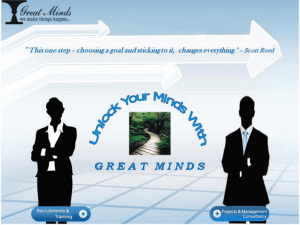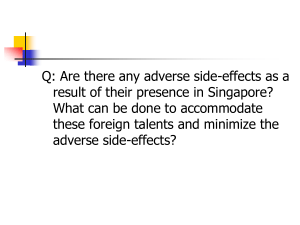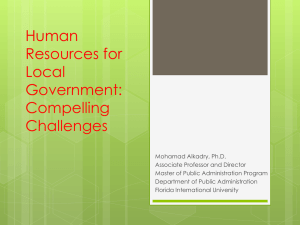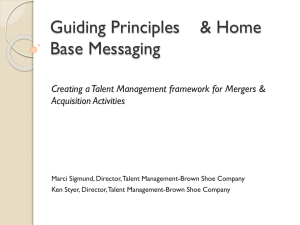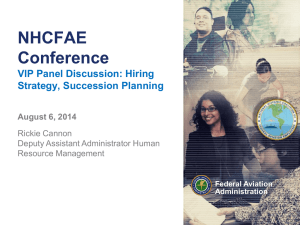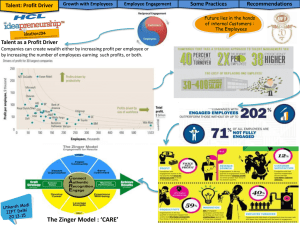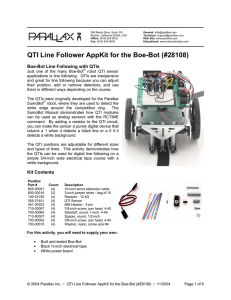Attract, Retain, Develop, and Engage the Best Talent
advertisement
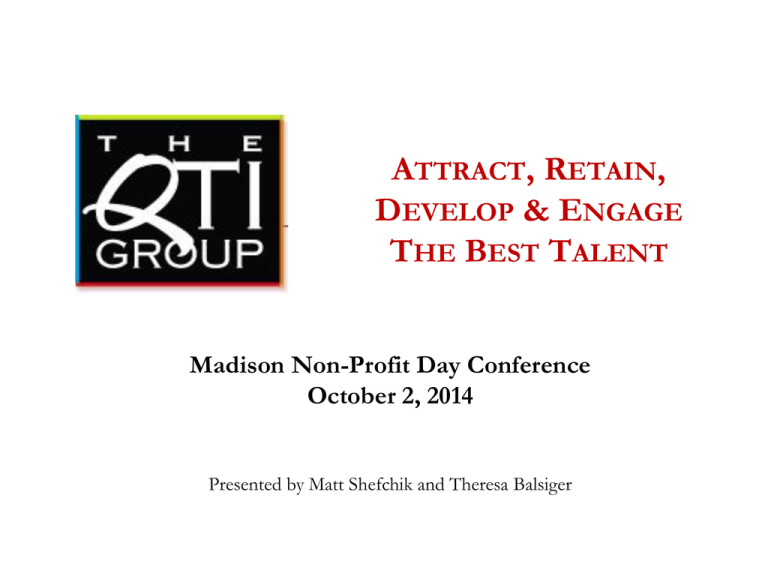
ATTRACT, RETAIN, DEVELOP & ENGAGE THE BEST TALENT Madison Non-Profit Day Conference October 2, 2014 Presented by Matt Shefchik and Theresa Balsiger QTI Group Overview The QTI Group has been an active member of the business community since 1957. Our key service areas of staffing, recruiting, HR Consulting, and HR Partnerships help businesses compete, gain ground, lead, and succeed. Staffing Focus on industrial, skilled, and administrative needs, from temporary help to contract-to-hire Recruiting Professional and executive recruitment practice HR Partnerships Offering HR/Payroll/Benefits services, HR assistance, HR investigations, HR assessments, and HR workshops HR Consulting 2 09/03/14 © QTI Consulting, Inc. Compensation administration, variable and incentive plans, employee engagement surveys, and succession planning Your Talent • In five years (2019), who are your organization’s top leaders/employees? How are these positions or people different from today? • What are you doing to develop these future leaders? • How do you find & attract talent today to fill critical positions? • How do you invest in making your culture have an competitive advantage? 3 © 2014, QTI Management Services, Inc. • What are your biggest talent challenges in 2014? Talent Trends in the Non-profit Industry 4 © 2014, QTI Management Services, Inc. • Non-profit organizations are hiring again! • 10.7 million employed by the nonprofit sector – 3rd largest US industry behind retail and manufacturing – Job growth is prevalent amongst all subsectors (health, arts/culture, human services, environmental, etc.) • Only 15% of non-profit organizations have a recruitment budget • 2013 turnover rate was 16% – Inability to pay competitively (32%) – Inability to promote top talent (19%) – Excessive workloads (16%) nonprofitHR 2014 Employment Practices Survey QTI 2014 Talent Planning Survey Talent Challenges in 2014 Respondents included for-profit and non-profit organizations in Wisconsin across a wide spectrum of industries and sizes. 5 © 2014, QTI Management Services, Inc. • Respondents view the following as “significant” to “moderate” challenges in 2014: 1. Attracting the right talent (80%) 2. Improving leadership development and succession planning (78%) 3. Preparing for healthcare reform (PPACA) (67%) 4. Enhancing employee engagement (67%) 5. Improving performance management (66%) 6. Retaining the right talent (58%) Finding, Attracting and Hiring Talent Quantity 7000 6000 5000 4000 Civilian Labor Force Population 3000 2000 1000 6 © 2014, QTI Management Services, Inc. 0 1960 1970 1980 1990 2000 2010 2020 2030 Bureau of Labor Statistics, OEA Finding, Attracting and Hiring Talent Quantity Projected Job Openings (2010-20) By Entry Level Education Doctoral or Professional Degree Master's Degree Bachelor's Degree 94730 Associate's Degree 28600 Postsecondary non-degree award 27740 53250 Some College, No Degree High School Diploma or Equivalent Less than High School 287590 218860 135310 107390 7 © 2014, QTI Management Services, Inc. Bureau of Labor Statistics, OEA Replacement Openings Growth Openings Finding, Attracting and Hiring Talent Quality Skilled 20% Unskilled 60% 8 © 2014, QTI Management Services, Inc. Professional 20% Then Unskilled 12% Professional 68% Skilled 20% Now Finding, Attracting and Hiring Talent Quality Tomorrow’s Jobs will Require Increased skills Tomorrow's Demand 48% 11% 41% Shift to higher skills Today's Supply 64% 10% 9 © 2014, QTI Management Services, Inc. < AD AD BS or > Source: ACS for Today’s skills; Moody’s Analytics for tomorrow’s Demand 26% Finding, Attracting and Hiring Talent Method • Post and pray recruiting strategies no longer work • Average number of applications a recruiter receives for a given job posting increased by 167% from 2007. – 100-300 names to produce one hire for a key position – 880 online visitors to yield one hire – Quality of many applicant pools is poor (35 percent of the typical applicant pool does not meet even the most basic job requirements) • Success comes from multi-source posting and proactive outreach – Propriety talent networks, aggregator sites, organization sites, referrals • 10 © 2014, QTI Management Services, Inc. Good News & Bad News: Passive candidates are more open to a conversation – 21% of full-time employees plan to change jobs in 2014, up from 17% last year – highest percentage in post-recession era – 45% “I’m happy with my job and not looking for another, but would be open to other opportunities.” Finding, Attracting and Hiring Talent Method • • CEB active-passive index – Tracks job search activity among workers going back to 2006 – Passive candidate pool is larger than it has been in the past 5 years – Over 50% in the passive category compared to 22% in 2006 The new normal for employment is just under five years Top ways passive candidates keep their options open 80% 70% 60% 50% 40% 30% 20% 10% 11 © 2014, QTI Management Services, Inc. 0% LinkedIn Referrals Recruiters Recruitment & Selection Process Poor Practices Anticipate the Need • • • • Specify the Job • • Best Practices Hiring only when you have an opening Having ad hoc succession plan Overlooking the skills your organization will need in the future Indulging in irrational optimism about attrition, succession depth, and recruiting yields • Relying on generic competency models Looking primarily for charisma, general ability and track record • • • • • • 12 © 2014, QTI Management Services, Inc. Conducting ongoing, proactive analysis of future needs Continually evaluating the pool of potential talent Developing rigorous periodic forecasts of the company’s talent needs Defining the specific demands of the job Specifying which skills and experience are relevant Identifying the team the candidate will need to work with Considering how company culture and context affect the role Recruitment & Selection Process Poor Practices Develop the Pool • • • Taking a scattershot, ad hoc approach to finding candidates Limiting the pool Looking for only external or internal candidates Best Practices • • • Assess the Candidates • • • • • • 13 © 2014, QTI Management Services, Inc. Settling on the first adequate choice Looking endlessly for the perfect choice Using the wrong interviewers Overly bureaucratic Unstructured or generic interviews Conducting inadequate (or no) reference checks • • • Developing a larger pool Considering people on the periphery of the organization (employees in remote offices, consultants, suppliers, customers) Tapping your networks and involving the right external partners Using a small number of highcaliber, well-trained interviewers Employing behavior based interviews Conducting detailed reference checks Recruitment & Selection Process Poor Practices Close the Deal • • Assuming money is everything Discussing only the positives of the job Best Practices • • • 14 © 2014, QTI Management Services, Inc. Integrate the Newcomer • Audit and Review • • • Assuming the new hire is “plug and play” Providing inadequate support and mentoring • Hanging on to bad hires Failing to review hiring practices and institutionalize the best ones • • • • Demonstrating accurate support for the candidates interests Describing the job realistically Involving the hiring manager personally, not just HR in closing the deal Using veteran top performers as mentors Making sure the newcomer checks in regularly with the boss, mentor and HR, even when no problems exist Removing bad hires immediately Regularly reviewing recruiting practices Holding all assessors accountable for the quality of their evaluations Workforce & Succession Planning 1. Strategic Plan Leads the Way 6. Monitor, Evaluate, Improve 2. Know What Talent You Need • • • Workforce & Succession Planning Proactive Sourcing Talent Pipelining 5. Recruit To Fill The Talent Gaps 15 • • © 2014, QTI Management Services, Inc. Create & Execute Development Plans Communicate Source: Adopted from U.S. OPM Succession Planning Process • • Retirements - next 5 yrs. Talent for new strategies Anticipated turnover 3. Know What Talent You Have 4. Do The Work – Succession & Development Strategies • 9 Box Performance & Potential Grid Retention & Engagement Best Practices Without significant ability, aspiration and engagement, employees will not excel in their next jobs. Aspiration Ability 16 © 2014, QTI Management Services, Inc. *Source: CEB Engagement The High-Potential Employee A high-potential employee is someone with the ability, engagement and aspiration to rise to and succeed in more senior critical positions. It takes both interpersonal and technical skills. Retention and Engagement Best Practices How do you create the culture where employees develop ability, give discretionary effort (engage) and aspire for more? 17 © 2014, QTI Management Services, Inc. Vision Voice More/Better Work Training & Development Recognition Flexibility Community at Work Extrinsic and Intrinsic Incentive Rewards • Individual motivation is linked to the availability of a system of extrinsic and intrinsic rewards Extrinsic Rewards Originates from outside the individual 18 © 2014, QTI Management Services, Inc. Intrinsic Rewards Originates from inside the individual Intrinsic Rewards • Factors increasing intrinsic motivation Challenge •People are more motivated when they pursue goals that have personal meaning, that relate to their self-esteem, when performance feedback is available, and when attaining the goal is possible but not necessarily certain. Curiosity •Internal motivation is increased when something in the physical environment grabs the individual’s attention (sensory curiosity) and when something about the activity stimulates the person to want to learn more (cognitive curiosity). Control •People want control over themselves and their environments and want to determine what they pursue. Cooperation & Competition •Intrinsic motivation can be increased in situations where people gain satisfaction from helping others and also in cases where they are able to compare their own performance favorably to that of others. Recognition 19 09/14/13 © QTI Consulting, Inc. •People enjoy having their accomplishment recognized by others, which can increase internal motivation. Finding, Attracting and Hiring Talent What Motivates Passive, Fully Engaged Employees? 80% 70% 73% 60% 59% 50% 40% 44% 30% 41% 40% Financial Stability of Company Work-life Balance 20% 10% 0% Compensation 20 © 2014, QTI Management Services, Inc. Growth Type of Work Opportunities What motivates candidates that are either passive or active that are NOT fully engaged? • Culture • Alignment • Their Boss 1Source: Novo Group Thank You We’ve got a talent for business.® We’ve got a talent for business.® Theresa Balsiger, PHR Matt Shefchik Executive Search Consultant QTI Professional Staffing, Inc. 702 E Washington Ave • PO Box 552 Madison, WI 53701-0552 608-663-4801 theresa.balsiger@qtigroup.com www.qtigroup.com Chief Operating Officer QTI Consulting, Inc. 702 E Washington Ave • PO Box 552 Madison, WI 53701-0552 608-663-4801 matt.shefchik@qtigroup.com www.qtigroup.com The QTI Group is the talent expert who understands, advises and connects, so that its customers can adapt, grow and succeed. 21 09/14/13 © QTI Consulting, Inc. The QTI Group is the talent expert who understands, advises and connects, so that its customers can adapt, grow and succeed. 22 © 2014, QTI Management Services, Inc.
